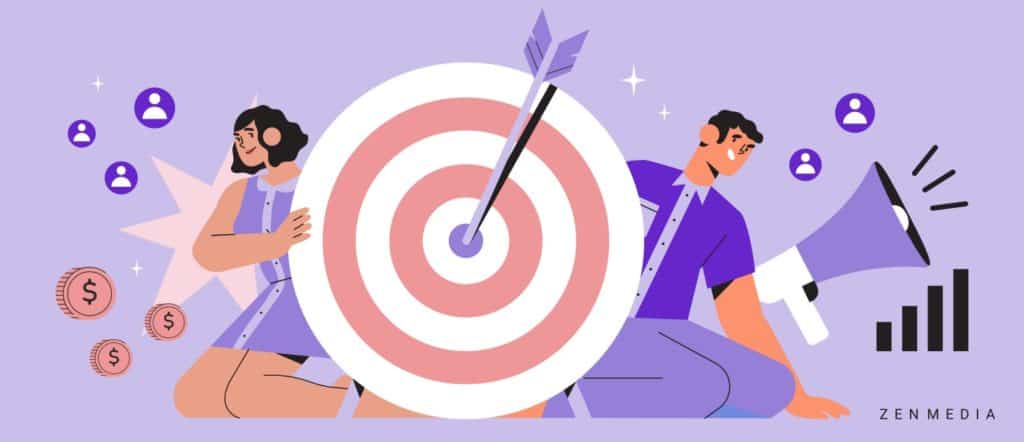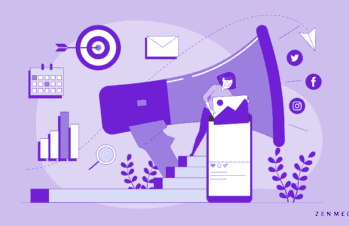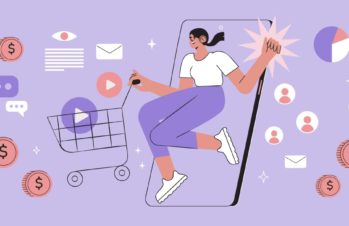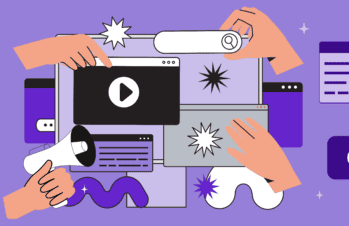Retargeting in B2B marketing is an essential part of executing a comprehensive and successful paid ads strategy. It drives conversions and increases the customer lifetime value by continually engaging with prospects and customers. On top of that, retargeting is a rather inexpensive way to spend an advertising budget. On average, Google Remarketing costs range from $0.66 to $1.23 per click. In comparison, Google search costs average between $1 to $2, and display ads costs average less than $1.
What is retargeting?
Retargeting, sometimes called remarketing, is the process of directly advertising to people who have already interacted with your brand in some way by showing interest in a product, application, or another conversion metric. These retargeted consumers may have lapsed from the conversion process, meaning they showed an indication of genuine interest but then left the sales funnel before converting. By retargeting these consumers directly with messaging personalized to their interests, brands can maximize conversions. But not all retargeting needs to be for consumers who have lapsed. Brands can also retarget current customers with new products complementary to previous purchases or special promos for birthdays, membership anniversaries, etc.
Simply investing in retargeting without the proper data, goals, and follow-through will only lead to disappointing results. Here are three retargeting strategies that will nearly guarantee results.
3 Retargeting Strategies for Optimal Results
1. Invest in quality leads, not low-cost conversions.
Not all conversions have the same weight; some are going to give you high-quality leads that have an active interest in purchasing, and others might not. But if you only focus on spending less money rather than investing in finding the highest-quality leads for your sales team, you’ll only end up with leads that either don’t convert or end up being clients that don’t last.
2. Track conversions throughout the sales funnel.
Many marketers track data from forms, website clicks, social media engagement, and more. But all of these are near the top of the sales funnel. What if, instead, they tracked the path of particular users from that website click, to filling out the form, to booking a call, to becoming a client?
If you only know how many leads a digital campaign produced (top-of-funnel stuff), you can’t make informed decisions about how to use that data in your future campaigns. For example, if Campaign A garnered 10 leads and one client booking but Campaign B produced only four leads, but three bookings, then Campaign B has a much higher conversion rate, and you only know this by tracking leads throughout the entire sales funnel.
3. Bid competitively and trust your conversion process.
Companies, especially those in the startup world, are no strangers to expensive costs for very high-intent search terms. What does that mean exactly?
It means that the search terms that users are most likely to use cost more because users have high intent to convert when they search with these terms—making them more valuable. Unfortunately, while retargeting is overall a cost-effective marketing tactic, the very best high-intent search terms can sometimes go for $30 to $60 per click. That’s a high cost to justify, so many marketers opt instead to go for lower-intent search terms or broader matches instead of specific ones.
With a retargeting campaign in place, marketers can bid on higher-intent search terms more confidently because retargeting is likely to convert leads down the line if they don’t convert initially. Two tools frequently used in retargeting strategies are Google Search and LinkedIn Ads.
Google Search and LinkedIn retargeting
Google Search and LinkedIn pay-per-click ads (PPC) should be familiar to most B2B paid advertising professionals, but you can combine their power in a retargeting strategy. Marketers can take the Google search traffic of ideal buyers and qualify them by retargeting through LinkedIn—inputting those characteristics along with industries their brand serves and targeting individuals with purchase power.
LinkedIn retargeting offers marketers the ability to get specific, including retargeting from website visits, contact lists, lead gen forms, video ads, events, and company page engagement. This way, LinkedIn Ads can provide these individuals with the personalized B2B content they are expecting, which ushers them further through the sales funnel.
After all, we know it can take 27 touchpoints for a prospect to convert. Personalization and earning trust are great ways to hasten the sales cycle. Brands can use retargeting to reinforce frequency bias. The more a person sees something, the more likely they are to trust it. If your prospects see personalized content over and over from you in the right places, they are more likely to convert and convert more quickly.
Related reading: How PR Shortens the Sales Cycle
Most people who view your ads aren’t going to convert on sight. Anyone who does is an anomaly, and that’s okay. Most won’t be ready or willing to buy what you are selling yet—and that’s why you retarget. The key is to keep showing up. Seeing your brand consistently, and tying it to the problem you’re solving, will reinforce to them that you are trustworthy and ready to solve their problem. This may take weeks, months, or even years—but following their journey through the retargeting process is a great way to make sure that they are seeing you consistently, shortening the sales cycle and increasing your odds of success.
Interested in how Google Search or LinkedIn retargeting ads can help your brand reach its goals? Reach out.




